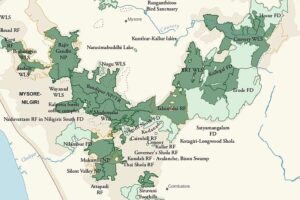Table of Contents
Nilgiri Biosphere Reserve
The Nilgiri Biosphere Reserve is a UNESCO-designated biosphere reserve located in the Western Ghats and Nilgiri Hills ranges of South India. The region has a rich and diverse history, which dates back to prehistoric times.
The Nilgiri Biosphere Reserve has first declared a wildlife sanctuary in 1936, and in 1986, it was recognized as a biosphere reserve by UNESCO. The biosphere reserve covers an area of 5,520 square kilometres and includes the Nagarhole National Park, Mudumalai National Park, and Bandipur National Park.
Read about: Biosphere Reserves in India
Nigiri Biosphere Reserve Map
The Nilgiri Biosphere Reserve is located in the Western Ghats of India and covers an area of about 5,500 square kilometres. The reserve is spread across three states of India: Tamil Nadu, Karnataka, and Kerala. Here is a look at its map.

Read about: Hydropower Plants in India
Nilgiri Biosphere Reserve Climate
The Nilgiri Biosphere Reserve has a pleasant and moderate climate throughout the year, owing to its location in the Western Ghats and Nilgiri Hills. The climate of the region is influenced by the monsoon winds, which bring heavy rainfall to the area from June to September.
The temperature in the region ranges from 10°C to 25°C throughout the year, with the highest temperatures recorded during the summer months of March to May. The winter months from November to January are the coolest, with temperatures ranging from 5°C to 15°C.
The region experiences two monsoon seasons, the southwest monsoon from June to September and the northeast monsoon from October to December. The average annual rainfall in the region ranges from 1,500 to 2,500 millimeters, with the highest rainfall occurring in the higher altitudes of the Nilgiri Hills.
Overall, the Nilgiri Biosphere Reserve has a pleasant and moderate climate throughout the year, with a significant amount of rainfall that supports the rich biodiversity of the region.
Read about: Major Ports in India
Nilgiri Bioshere Reserve Vegetation
The Nilgiri Biosphere Reserve is known for its rich and diverse vegetation, which includes a wide variety of forests, grasslands, and wetlands. The vegetation in the region is classified into several types based on their altitude and climatic conditions. Here are some of the major types of vegetation found in the Nilgiri Biosphere Reserve:
| S. No | Vegetation Type | Description |
| 1 | Tropical Wet Evergreen Forests | These forests are found in the lower elevations of the reserve and are characterized by tall trees with dense foliage. The trees in these forests are evergreen and have a rich undergrowth of shrubs and herbs. |
| 2 | Tropical Moist Deciduous Forests | These forests are found in the mid-elevations of the reserve and are characterized by trees that shed their leaves during the dry season. The trees in these forests are deciduous and have a variety of undergrowth including bamboo, grasses, and shrubs. |
| 3 | Shola Forests | These forests are found in the higher elevations of the reserve and are characterized by short, stunted trees and dense undergrowth of grasses, shrubs, and herbs. Shola forests are unique to the Western Ghats and are an important habitat for a variety of endemic species. |
| 4 | Grasslands | The grasslands in the Nilgiri Biosphere Reserve are found in the lower elevations of the reserve and are characterized by tall grasses and scattered trees. The grasslands provide important habitats for a variety of herbivorous mammals, including elephants, bison, and deer. |
| 5 | Wetlands | The wetlands in the Nilgiri Biosphere Reserve include lakes, ponds, and swamps that provide an important habitat for a variety of aquatic and semi-aquatic plants and animals. |
Read about: Nuclear Power Plants in India
Nilgiri Biosphere Reserve Fauna
The Nilgiri Biosphere Reserve is known for its rich and diverse fauna, with a large number of plant and animal species found in the region. Here are some of the major types of fauna found in the Nilgiri Biosphere Reserve:
| S. No | Fauna | Description |
| 1 | Mammals | The Nilgiri Biosphere Reserve is home to a large number of mammal species, including Asian elephants, tigers, leopards, Indian bison (gaur), sambar deer, spotted deer, Indian muntjac, and the Nilgiri tahr, which is a rare mountain goat endemic to the region. |
| 2 | Birds | The reserve is also home to a large number of bird species, including several endemic species such as the Nilgiri wood pigeon, Nilgiri flycatcher, Nilgiri laughingthrush, and the Nilgiri pipit. Other common bird species found in the reserve include raptors, parakeets, hornbills, and kingfishers. |
| 3 | Reptiles | The reserve is home to several species of snakes, including the king cobra, Indian rock python, and the common krait. Lizards such as the monitor lizard and skinks are also found in the region. |
| 4 | Amphibians | The reserve has a high diversity of amphibians, with over 80 species recorded, including the endangered Malabar gliding frog, the torrent frog, and the Indian bullfrog. |
| 5 | Insects | The reserve is home to a diverse range of insects, including butterflies, moths, beetles, and spiders. |
Nilgiri Biosphere Reserve Tourism
The Nilgiri Biosphere Reserve is a popular destination for ecotourism in India, attracting thousands of visitors every year. The reserve offers a wide range of activities for tourists, including trekking, bird watching, wildlife safaris, and nature walks.
The best time to visit the Nilgiri Biosphere Reserve is between the months of October and May, which is the winter and summer season in the region. During this time, the weather is pleasant with clear skies, making it ideal for outdoor activities like trekking, wildlife spotting, and bird watching. The monsoon season in the region starts in June and lasts until September, during which the reserve receives heavy rainfall, and many of the tourist attractions may be closed due to safety concerns.
Therefore, it is best to avoid visiting the reserve during the monsoon season. It’s important to note that the weather in the Western Ghats can be unpredictable, and it’s always a good idea to check weather forecasts before planning a trip to the Nilgiri Biosphere Reserve.
Read about: List of Elephant Reserves in India
Nilgiri Biosphere Reserve UPSC
The Nilgiri Biosphere Reserve is an important topic for the UPSC Syllabus, as it is one of the most important biosphere reserves in India. The UPSC exam often includes questions related to the geography, biodiversity, and conservation efforts in the Nilgiri Biosphere Reserve. It is important for aspirants to have a thorough understanding of the region’s flora, fauna, and socio-economic factors to effectively answer questions related to the topic. Additionally, the UPSC exam may also include questions related to the history of the Nilgiri Biosphere Reserve, its tourism potential, and its significance in the context of sustainable development.
You can check out the official StudyIQ UPSC Online Coaching website to gain a better understanding of how to prepare effectively for the UPSC exam. Also, the official StudyIQ UPSC online coaching website provides the opportunity to practice UPSC Mock Test for Prelims 2023, which can help you assess your level of preparedness for the exam.
Read about: Tiger Reserves in India


 Repo Rate and Reverse Repo Rate, Impact ...
Repo Rate and Reverse Repo Rate, Impact ...
 Foreign Contribution Regulation Act (FCR...
Foreign Contribution Regulation Act (FCR...
 Urban Cooperative Banks in India, Functi...
Urban Cooperative Banks in India, Functi...





















